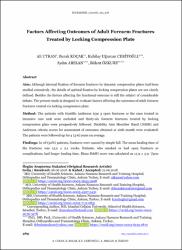Factors Affecting Outcomes of Adult Forearm Fractures Treated by Locking Compression Plate
Abstract
Aim: Although internal fixation of forearm fractures by dynamic compression plates had been studied extensively, the details of optimal fixation by locking compression plates are not clearly defined. Besides the factors affecting the functional outcome is still the subject of considerable debate. The present study is designed to evaluate factors affecting the outcomes of adult forearm fractures treated via locking compression plate. Method: The patients with Gustillo Anderson type 3 open fractures or the ones treated in intensive care unit were excluded and thirty-six forearm fractures treated by locking compression plate were prospectively followed. Disability Arm Shoulder Hand (DASH) and Anderson criteria scores for assessment of outcomes obtained at sixth month were evaluated. The patients were followed up for 4 (3-6) years on average. Findings: In 18 (50%) patients, fractures were caused by simple fall. The mean healing time of the fractures was 13.2 ± 2.1 weeks. Patients, who smoked or had open fractures or complications, had longer healing time. Mean DASH score was calculated as 13.9 ± 5.9. Upon presence of open fracture or postoperative complication there was a significant deterioration in scores. Although the cause of the injury had some effect on functional results the mechanism (whether the injury was direct or indirect) made no difference. Conclusion: Fracture type was the most important factor affecting both healing time and outcome. Being an open fracture or the presence of postoperative complication deteriorates the outcome. The functional results were somewhat poorer in fractures caused by simple fall. Amaç: Önkol kırıklarının dinamik kompresyon plağı kullanılarak yapılan internal tespiti ile ilgili birçok çalışma bulunmakla birlikte, kilitli kompresyon plakları ile yapılacak en uygun fiksasyonun detayları henüz yeterince tanımlanmamıştır. Ayrıca fonksiyonel sonucu etkileyen faktörler halen tartışma konusudur. Bu çalışmanın amacı, kilitli kompresyon plağı kullanılarak tedavi edilen önkol kırıklarının klinik sonuçlarına etkiyen faktörleri değerlendirmektir. Yöntem: Gustillo Anderson tip 3 açık kırığı olan veya yoğun bakımda yatan hastalar hariç tutularak, kilitli kompresyon plağı ile tedavi edilen 36 önkol kırığı hastası prospektif olarak değerlendirildi. Altıncı ayda Disability Arm Shoulder Hand (DASH) skoru ve klinik sonuçların değerlendirilmesi için kullanılan Anderson kriterleri skorları ile değerlendirildi. Hastalar ortalama 4 (3-6) yıl takip edildi. Bulgular: On sekiz hastada (%50) kırık nedeni basit düşmeydi. Ortalama iyileşme süresi 13.2±2.1 hafta olarak bulundu. Sigara içen hastaların veya açık kırığı olanların ya da ameliyat sonrası komplikasyon gelişen hastaların iyileşme süresi daha uzundu. Ortalama DASH skoru 13.9±5.9 hesaplandı. Açık kırık veya komplikasyon varlığının skorlar üzerinde anlamlı olumsuz etki yaptığı belirlendi. Yaralanma nedeninin fonksiyonel sonuçlara az da olsa etkisi olmasına rağmen yaralanma mekanizmasının (direkt ya da dolaylı olmasının) istatistiksel anlamlı bir etkisi saptanmadı. Sonuç: Hem iyileşme zamanı hem de klinik sonuçlara etki eden en önemli faktörün kırık tipi olduğu tespit edildi. Açık kırık yada ameliyat sonrası komplikasyon varlığı sonuçları kötü yönde etkilemektedir. Basit düşmeye bağlı gelişen kırıklarda fonksiyonel sonuçlar biraz daha kötü olmaktadır.

















